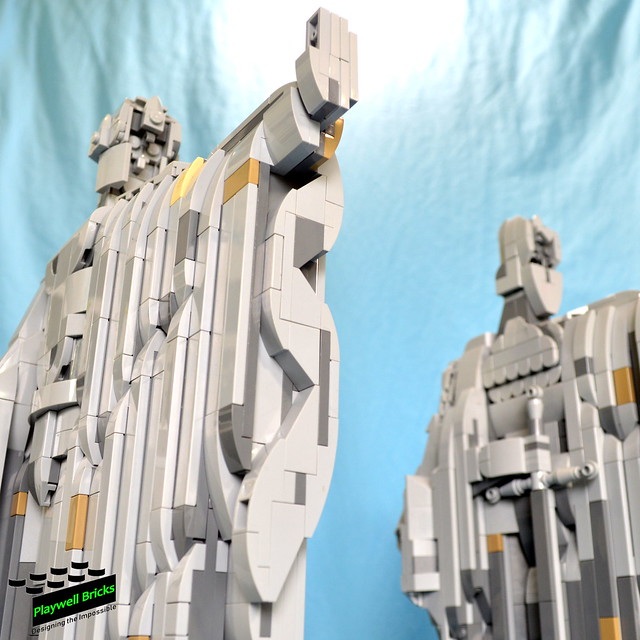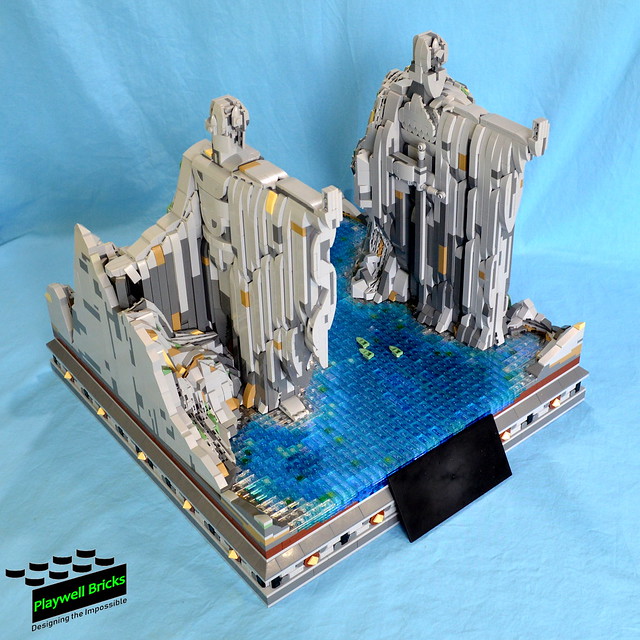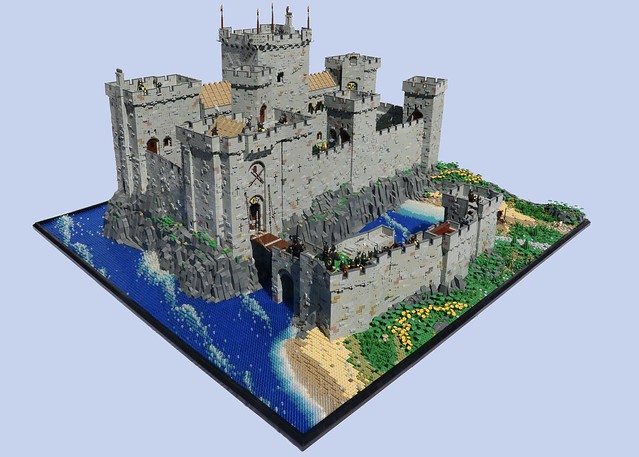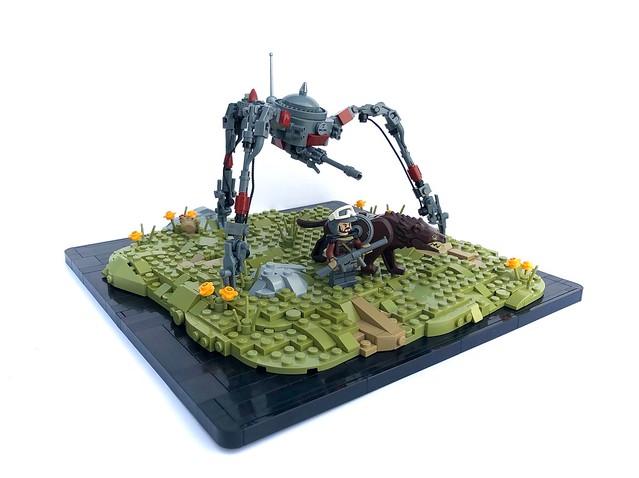Messing with the timeline? You’d better watch out — the Commission are bound to send their best agents after you. Jonas Kramm takes inspiration from Netflix’s dramatisation of Gerard Way and Gabriel Bá’s Umbrella Academy, putting together this cool pair of busts depicting Cha-Cha and Hazel, a pair of professional time-travelling assassins. For those who haven’t seen the show, the pair of killers arrive in our time wearing huge carnival costume heads. Jonas has perfectly captured their sinister yet cartoon-like appearance, and the use of umbrellas as neckties works well for the suits but also acts as a nice little nod to the show’s title. If only we could use Cha-Cha and Hazel’s time-travelling abilities to make season 2 arrive a little sooner.
Posts by Rod
Behold the Argonath, the Pillars of the Kings
Gondor is the greatest kingdom of Men during the Third Age of Tolkien’s Middle-Earth. Its northern borders are marked by The Argonath, a pair of huge statues standing on the banks of the River Anduin. Jason Pyett has taken on the challenge of building a LEGO version of this dramatic location from The Lord Of The Rings, and the result is an impressive piece of microscale building.
The statues tower above the river, their left hands raised in warning to the enemies of Gondor. The choice of colours and level of detailing manage to evoke the idea of weathered stonework, and the proportions of both figures are nicely done. Fun fact: Jason has built the movie version of this monumental pair — depicting Isildur on the left, and Elendil on the right, armed with the sword Narsil. In the original description from the books, the statues depicted Isildur and his brother Anarion, and both were armed with axes.
Used car for sale: 1971 plates. Buyer must collect. Price: $9.5m
It’s the most expensive car ever made, and although four models were manufactured originally, only one remains on the planet. Three Lunar Roving Vehicles were carried to the Moon on Apollo missions 15, 16, and 17, with one spare kept behind on Earth. Those four aluminium-framed buggies cost a grand total of $38m back in 1971, making each of the four worth nearly $10m back then. You have to imagine if someone were to salvage the buggies from the lunar surface now, these things would be priceless. If you fancy a Lunar Vehicle of your own, it’s probably not worth saving up, and consider rather taking a leaf out of Robson M‘s book and building a LEGO version.
This is a cracking little LEGO model — relatively simple construction, but immediately recognisable with just enough detail to capture its inspiration. And the presentation is top-notch, perfectly echoing the high-contrast photos of the Apollo missions. My only gripe? Those rubber tyres. The real LRV had aluminium mesh wheels to cope with the extremes of temperature and to throw off the lunar dust. But tyres aside, I still want one of these to go with my 10266 Lunar Lander set — turning it from a depiction of the first manned landing, into one of those last trips (for now) which we took to our nearest celestial neighbour.
LEGO version of Florence’s Santa Maria del Fiore
Good LEGO microscale buildings manage to capture the essence of their subject, but the very best also trick the eye into looking much bigger than they really are. Rocco Buttliere showcases his skills once more, this time tackling the UNESCO-listed Santa Maria del Fiore in Florence.
The real thing took 140 years to complete and is a masterpiece of Italian Gothic. Rocco’s version is a masterpiece of microscale, standing maybe only 20 bricks high, but somehow feeling much larger. That’s a testament to the level of detail packed into the model, the result of studs-in and studs-out building, and a great selection of parts, including two types of turntable bases, grille tiles, tooth bricks, Technic pins, and lightsaber hilts. Match all that with a beautifully captured dome, and a smart colour scheme, and you end up with a LEGO church which is fully worth of your praise.
The Demon’s price seems reasonable — he only wants your soul
Demons stalk the night. Or at least they do in Jayfa‘s world. This LEGO Bionicle creation is a wonderfully dark and brooding character, put together using a prototype mask and custom-designed wing membranes. The pose is excellent, powerful and intimidating, and the colour scheme is spot-on — those splashes of trans-blue work brilliantly with the pearl gold against all the black. Inexperienced warlocks beware, this probably wasn’t the low-level denizen of the Netherworld you meant to summon…
Jumping on board the Mexican bandwagon
Most Western-themed LEGO creations take their architectural inspiration from the single-street towns of the Gold Rush — clapperboard buildings, usually saloons and general stores. It makes for a pleasant change to see something a little more Southwestern in tone with Andrea Lattanzio‘s build of a classic whitewashed adobe flat-roofed house. And even better, there’s not a gunfighter in sight; instead, we’re treated to a mariachi band arriving in their wagon to serenade the farmer’s beautiful daughter. The house is a visual treat, covered with nice details, from the use of printed 1×1 round tiles on the protruding ends of the logs to the plant-covered arbors that provide shady spots on the flat roof. The use of woodgrain tiles above the windows and doors adds some welcome texture amongst the white. Bien hecho, Andrea!
A glorious day down on the farm
LEGO Castle is a building style dominated, perhaps understandably, by LEGO castles. It’s good to see the less militaristic side of medieval life depicted in the bricks — particularly when it’s as well done as this Manor House and farm scene by Peter Ilmrud. The main building is excellent — stone walls evoked with lots of texture, a nicely-built thatched roof, and the typical “Mock Tudor” woodwork enlivened with sand green window frames. The surrounding farm is wonderfully detailed with a field of corn, a carrot and pumpkin patch, a paddock for the horses, and a filthy-looking pig sty.
A lower-angle image gives a nice close-up view of some of the finer details, including the attention paid to the different types of paving and path, the tiled roof of the outbuilding, and those wonderful crops…
Reactor online, sensors online, weapons online
1984’s BattleTech brought the mech designs of Japanese anime crashing into Western table-top gaming. Two years later, MechWarrior expanded the universe into a wider role-playing game. These two games were responsible for introducing a whole generation to the glorious concept of giant mechanical walkers shooting at one another. Kale Frost has put together a cracking LEGO version of the Timber Wolf mech — the series’ signature design. The details are spot-on with the upper body slewing to the left on spindly legs whilst missiles burst into the air from the shoulder-mounted pods. All systems nominal.
And I’ll have that coffee to go...
A coffee delivery service is a great business idea. Especially if the mugs of boiling liquid come rushing towards you on servo-powered legs. Hmmm. Hang on. Perhaps that’s actually a rubbish business idea? Regardless, Markus Rollbühler‘s madcap vision of the Coffee Of The Future makes for a cracking LEGO creation. The legs and cup-holding limbs are gloriously detailed, packed full of functional-looking greebly bits, and the little splash of bright blue adds a lovely touch of colour amongst the light grey and silver. Brilliantly bonkers stuff.
Enormous LEGO castle dominates the shoreline
If a medieval castle was an exercise in the projection of power, we’ve got a new Lord of the Manor on the scene in Joel Midgley. His latest LEGO project is Hingston Castle, a formidable fortress, impressive in both scale and details. The sheer size of the castle grabs the initial attention, but then you’re sucked in by the little touches — the lovely shoreline landscaping, the water, the roughness of the walls, the off-grid angles of the outer rampart. And as for that dark grey line tracing the contours of the crenellations — beautiful!
Joel has lavished as much attention to detail on the action within the walls as without. The central yard plays host to grazing animals, trees and flowers, patrolling guards, and stables…
Best of all, hinged panels in those walls allow visibility of the castle’s fully-detailed interior. Click to take a tour of this incredible LEGO castle…
Cry havoc and let slip the wolves of war
Steam-driven military walkers are a staple of the LEGO Steampunk building genre, and this one, by Carter Witz, is a great addition to the corps — a spindly tripod affair with touches of dark red in amongst the grey greebles. The functional-looking joints on the legs support a nicely detailed body packed with texture (and armaments).
I particularly liked the evocation of a classic Prussian-esque “pickelhaube” spiked helmet. This is one of those LEGO creations where the presentation adds immensely to the overall effect. The base is simple but well done, and the addition of the figures advancing beneath their mechanical companion gives an impression of scale the central model alone might lack. And dropping in that wolf is a masterstroke — immediately creating a sense of mystery, danger, and otherworldliness. Steampunk needs more wolves.
Give me a career as a buccaneer, the life of a pirate for me
Ah, the pirate life — it’s all palm trees and rum, blue skies and treasure chests. Oh, and scurvy. And tropical insects. And crabs. Regardless of the reality of the pirating lifestyle, it remains a perennially popular subject for LEGO builders. Here’s Isaac Snyder‘s take on a small pirate hideaway — Cutthroat Cove — a rough wooden shelter built into the rock, complete with jetty and a lookout position on the cliffs above. The vegetation and the dual-coloured rockwork are nicely done, and the mix of browns used for the shelter gives it an appropriately ramshackle feel.














